Quan Su Pagoda, also known as Ambassadors’ Pagoda, is not just a serene escape in the heart of bustling Hanoi, Vietnam; it is a significant symbol of Vietnamese Buddhism, serving as the headquarters of the Vietnam Buddhist Sangha. SIXT.VN understands that exploring cultural landmarks like Quan Su Pagoda offers a deeper understanding of Vietnam’s heritage and spiritual traditions. Let SIXT.VN be your guide, providing seamless travel solutions for your journey of discovery, including airport transfers, comfortable accommodations, and curated tours.
1. What is Quan Su Pagoda and Where is it Located?
Quan Su Pagoda is a prominent Buddhist temple in Hanoi, Vietnam, serving as the headquarters of the Vietnam Buddhist Sangha. It is located at 73 Quan Su Street, Hoan Kiem District, Hanoi. This central location makes it easily accessible to visitors and locals alike, offering a tranquil escape from the city’s vibrant energy. According to Hanoi Statistics Office, Hoan Kiem District is the most visited location by tourists.
1.1. How to Get to Quan Su Pagoda
Getting to Quan Su Pagoda is convenient, with various transportation options available:
- By Car/Taxi: From the center of Hanoi, follow Le Thai To Street to the Ba Trieu intersection and turn right. Continue straight until you reach Quan Su Street. Taxis and ride-hailing services are readily available in Hanoi. Consider booking a private car with SIXT.VN for a comfortable and hassle-free journey.
- Public Transportation: Several bus lines stop near Quan Su Pagoda, including 01, 02, 09, 32, and 40. Bus travel is an affordable way to reach the pagoda.
- Walking: If you’re staying near Hoan Kiem Lake, Quan Su Pagoda is within walking distance, allowing you to explore the surrounding streets and experience the local atmosphere.
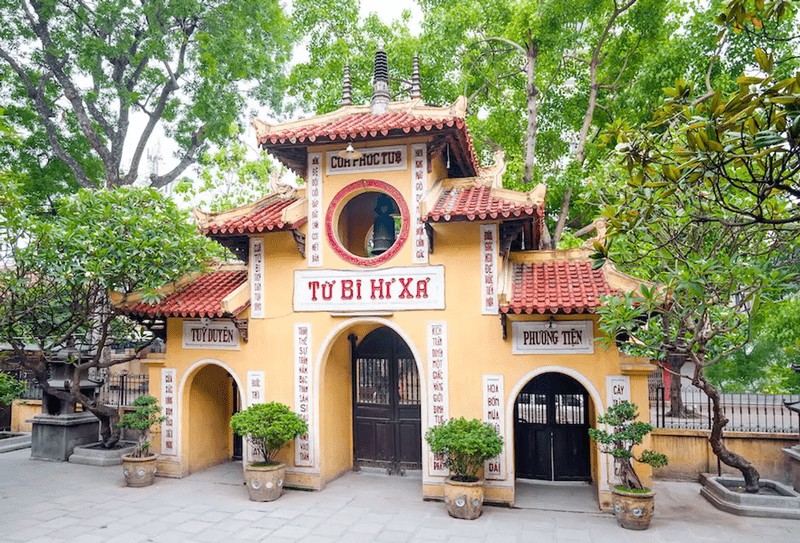 Getting to Quan Su Pagoda with Ease
Getting to Quan Su Pagoda with Ease
1.2. Quan Su Pagoda Opening Hours
Quan Su Pagoda welcomes visitors every day from 6:00 am to 7:00 pm. The temple may extend its hours during public holidays and special Buddhist events. It’s best to check the schedule in advance if you plan to visit during these times.
2. What is the Significance of Quan Su Pagoda?
Quan Su Pagoda holds immense significance as the headquarters of the Vietnam Buddhist Sangha, the largest Buddhist organization in Vietnam. The pagoda plays a central role in Vietnamese Buddhism, serving as a hub for religious activities, cultural events, and Buddhist studies. The pagoda serves as a place of worship, study, and community for Buddhist practitioners. Quan Su Pagoda is a symbol of national unity, bringing together Buddhists from across Vietnam.
2.1. Historical Roots of Quan Su Pagoda
Dating back to the 15th century during the Le Dynasty, Quan Su Pagoda was initially established as a guesthouse for foreign emissaries, particularly those from Buddhist countries. Over time, it evolved into a prominent Buddhist temple, reflecting the deep-rooted influence of Buddhism in Vietnamese society. King Le Hy Tong, in 1664, authorized its transformation into a dedicated place of worship, solidifying its status as a significant spiritual center.
2.2. The Role of Quan Su Pagoda in Vietnamese Buddhism
Quan Su Pagoda stands as a central hub for Vietnamese Buddhism, hosting numerous religious ceremonies, festivals, and conferences. It also houses a library and research center, contributing to the preservation and promotion of Buddhist teachings. The pagoda is actively involved in social and charitable activities, providing support to the local community.
2.3. Quan Su Pagoda’s Architectural Significance
Quan Su Pagoda showcases traditional Vietnamese architectural styles, with intricate carvings, ornate decorations, and a serene courtyard. The pagoda complex includes various halls, shrines, and towers, each serving a specific purpose. The architecture reflects the harmony between Buddhist principles and Vietnamese cultural aesthetics.
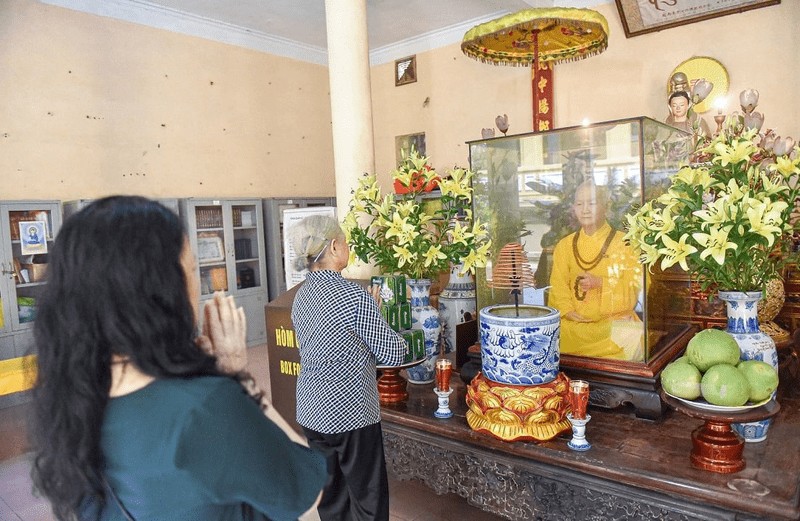 Quan Su Pagoda Reflects Vietnamese Buddhism
Quan Su Pagoda Reflects Vietnamese Buddhism
3. Who Does Quan Su Pagoda Worship?
Quan Su Pagoda is dedicated to various Buddhist deities, including:
- Buddhas: Statues of Shakyamuni Buddha (the historical Buddha), Amitabha Buddha (Buddha of the Western Pure Land), and other Buddhas are enshrined in the pagoda.
- Bodhisattvas: Avalokiteshvara (Quan Am), the Bodhisattva of Compassion, and Manjushri (Van Thu), the Bodhisattva of Wisdom, are among the prominent Bodhisattvas venerated at Quan Su Pagoda.
- National Teachers: The pagoda honors notable Vietnamese Buddhist teachers who have made significant contributions to the development of Buddhism in Vietnam.
3.1. The Significance of Each Deity
Each deity represents different aspects of Buddhist teachings and ideals. The Buddhas embody enlightenment and the path to liberation. Bodhisattvas exemplify compassion, wisdom, and the dedication to helping others achieve enlightenment. National Teachers serve as role models for Buddhist practitioners, inspiring them to follow the path of Dharma.
3.2. The Arrangement of Statues and Shrines
The arrangement of statues and shrines within Quan Su Pagoda reflects the rich history of Vietnamese Buddhism and the diverse beliefs of its followers. The main sanctuary houses the principal Buddha statues, while other halls and shrines are dedicated to specific deities or purposes.
4. What Are the Key Architectural Features of Quan Su Pagoda?
Quan Su Pagoda exemplifies traditional Northern Vietnamese architecture, harmoniously blending elegance, simplicity, and symbolic design. The pagoda’s structure reflects the connection between the individual and the nation, embodying the essence of Vietnamese culture.
4.1. The Courtyards: A Symbolic Representation
The pagoda features two courtyards, each representing a significant aspect of Vietnamese society:
- Inner Courtyard: Shaped like the Chinese character “Công” (工), symbolizing “work” or “labor,” representing the individual’s effort and contribution to society.
- Outer Courtyard: Shaped like the Chinese character “Quốc” (國), symbolizing “country” or “nation,” representing the collective identity and shared destiny of the Vietnamese people.
4.2. Key Structures within the Pagoda Complex
The Quan Su Pagoda complex comprises various structures, each with its unique architectural features:
- Three-Story Bell Tower: This towering structure houses a large bell used to announce important events and ceremonies.
- Main Sanctuary: The central hall where the principal Buddha statues are enshrined and where religious services are held.
- Surrounding Halls: These halls are dedicated to various deities, ancestral spirits, and other religious figures.
- Intricate Woodwork: The pagoda’s woodwork is adorned with elaborate carvings depicting dragons, phoenixes, floral patterns, and Buddhist symbols, showcasing the skill and artistry of Vietnamese craftsmen.
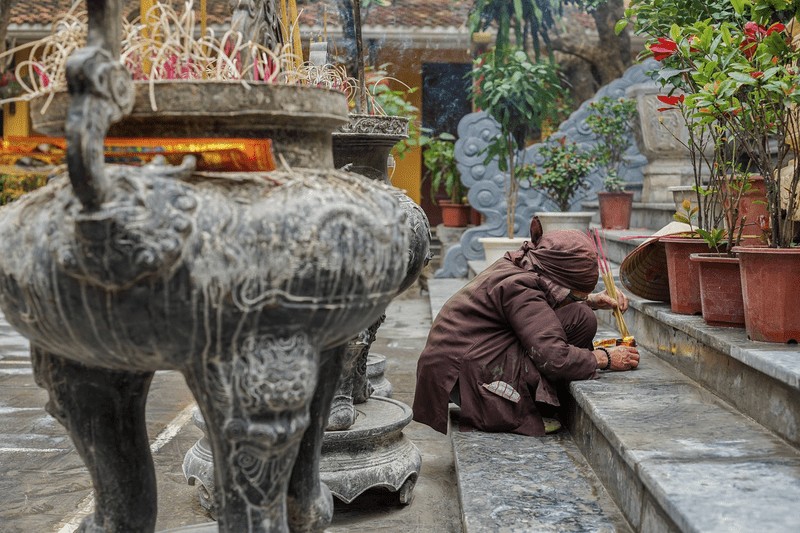 Quan Su Pagoda's Architecture – Ancient Style of the North
Quan Su Pagoda's Architecture – Ancient Style of the North
5. What Sets Quan Su Pagoda Apart from Other Pagodas in Vietnam?
While many pagodas in Vietnam incorporate elements of folk beliefs, Quan Su Pagoda strictly adheres to Buddhist principles. This focus on Buddhist teachings and practices distinguishes it from other temples that may incorporate local deities or traditions.
5.1. Exclusively Buddhist Worship
Quan Su Pagoda is exclusively dedicated to Buddhist deities, including Buddhas, Bodhisattvas, and National Teachers. Unlike some other pagodas in Vietnam, Quan Su Pagoda does not include shrines dedicated to folk deities or the Mother Goddess of the Three Palaces.
5.2. The Central Headquarters of the Vietnam Buddhist Sangha
As the central headquarters of the Vietnam Buddhist Sangha, Quan Su Pagoda plays a pivotal role in the organization and administration of Buddhist affairs in Vietnam. This position gives it a unique authority and influence within the Vietnamese Buddhist community.
5.3. Use of Quoc Ngu in Inscriptions
Quan Su Pagoda stands out for using Quoc Ngu, the Vietnamese national script, in all inscriptions and writings. This contrasts with older temples that often use Chinese characters. Using Quoc Ngu makes Buddhist teachings more accessible to the general public, especially those who are not literate in Chinese.
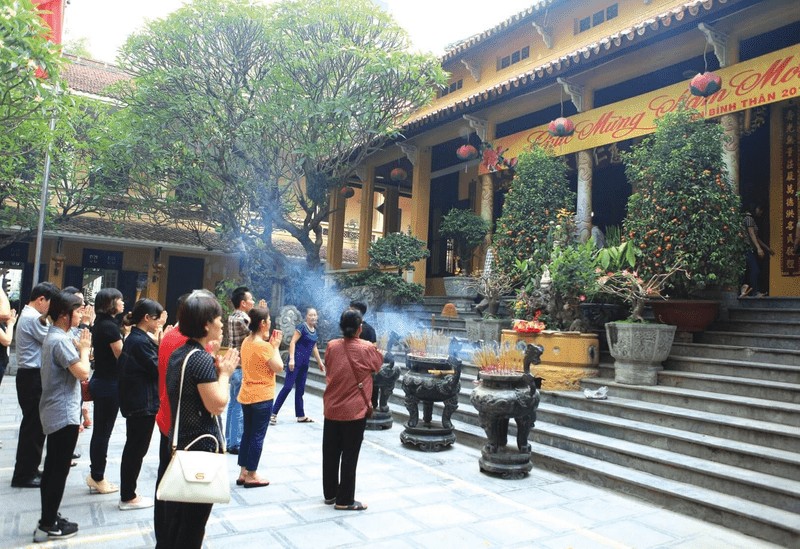 Central Headquarters of the Vietnam Buddhist Sangha
Central Headquarters of the Vietnam Buddhist Sangha
6. How Does Quan Su Pagoda Contribute to Vietnamese Buddhist Education?
Quan Su Pagoda plays a crucial role in Vietnamese Buddhist education by providing resources, facilities, and opportunities for Buddhist studies and scholarship.
6.1. Library and Research Institute
The pagoda houses an extensive library containing Buddhist scriptures, commentaries, and scholarly works. It also has a research institute dedicated to studying and promoting Buddhist teachings.
6.2. Lecture Halls and Educational Programs
Quan Su Pagoda offers lecture halls where monks, scholars, and teachers conduct classes and seminars on various aspects of Buddhism. The pagoda also organizes educational programs for the public, aiming to promote Buddhist knowledge and practices.
6.3. Supporting Buddhist Monasteries and Seminaries
Quan Su Pagoda provides support to Buddhist monasteries and seminaries across Vietnam, helping to train and educate future generations of Buddhist leaders and practitioners.
7. How Does Quan Su Pagoda Promote Unity Among Vietnamese Buddhists?
Quan Su Pagoda plays a significant role in promoting unity and harmony among Vietnamese Buddhists, representing different schools and traditions.
7.1. Centralized Authority
As the headquarters of the Vietnam Buddhist Sangha, Quan Su Pagoda serves as a central coordinating body for Buddhist activities and initiatives nationwide. This centralized authority helps to foster a sense of shared identity and purpose among Vietnamese Buddhists.
7.2. Interfaith Dialogue
Quan Su Pagoda actively promotes interfaith dialogue and cooperation, building bridges with other religious communities in Vietnam. This fosters mutual understanding and respect, contributing to social harmony and national unity.
7.3. Cultural Events and Festivals
Quan Su Pagoda hosts numerous cultural events and festivals throughout the year, attracting Buddhists from all walks of life. These events provide opportunities for people to come together, share their experiences, and celebrate their common faith.
8. What Should You Know Before Visiting Quan Su Pagoda?
Visiting Quan Su Pagoda is a unique experience. To ensure a respectful and enriching visit, here are some important notes:
8.1. Dress Code
Dress modestly and respectfully. Avoid wearing revealing clothing, such as shorts, tank tops, or low-cut dresses. Shoulders and knees should be covered.
8.2. Etiquette
Maintain silence and avoid loud conversations, especially in prayer areas. Refrain from touching or moving any objects without permission. Show respect for the monks, nuns, and other visitors.
8.3. Photography
Photography is generally allowed, but avoid using flash, which can be disruptive to others. Ask for permission before taking photos in restricted areas.
8.4. Offerings
If you wish to make an offering, follow the guidance provided by the temple staff. Typically, offerings of flowers, fruits, or incense are appropriate.
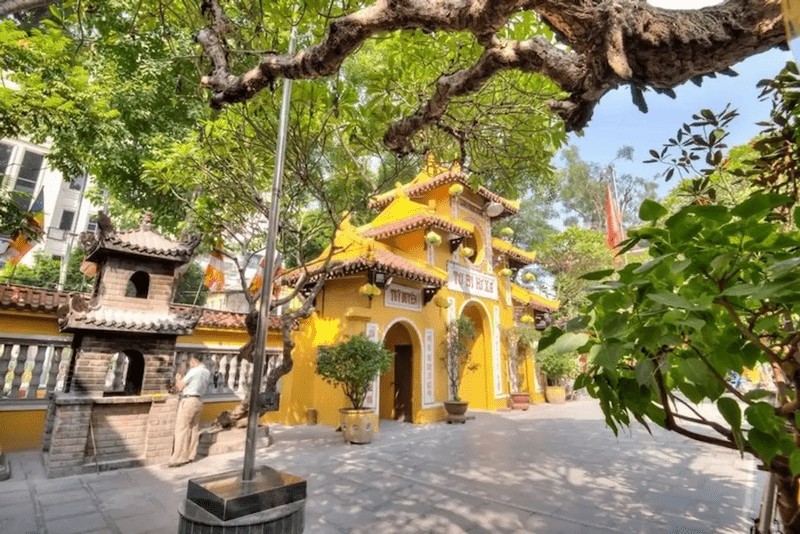 Notes for Visiting Quan Su Pagoda
Notes for Visiting Quan Su Pagoda
9. What Tourist Attractions Are Near Quan Su Pagoda?
Quan Su Pagoda’s central location in Hanoi makes it a convenient starting point for exploring other nearby attractions:
9.1. Hoa Lo Prison
A short walk from Quan Su Pagoda, Hoa Lo Prison offers a glimpse into Vietnam’s colonial past. This former prison was used to house Vietnamese political prisoners and later American prisoners of war during the Vietnam War.
9.2. Thang Long Imperial Citadel
A UNESCO World Heritage Site, Thang Long Imperial Citadel is a complex of historical structures that served as the political center of Vietnam for centuries. Explore the excavated remains of palaces, temples, and fortifications.
9.3. Ho Chi Minh Mausoleum
Pay respects to Vietnam’s revolutionary leader, Ho Chi Minh, at his final resting place. Visitors can view his embalmed body and learn about his life and legacy.
9.4. Hoan Kiem Lake
Take a leisurely stroll around Hoan Kiem Lake, a scenic lake in the heart of Hanoi. Visit Ngoc Son Temple, located on a small island in the lake, accessible by a picturesque bridge.
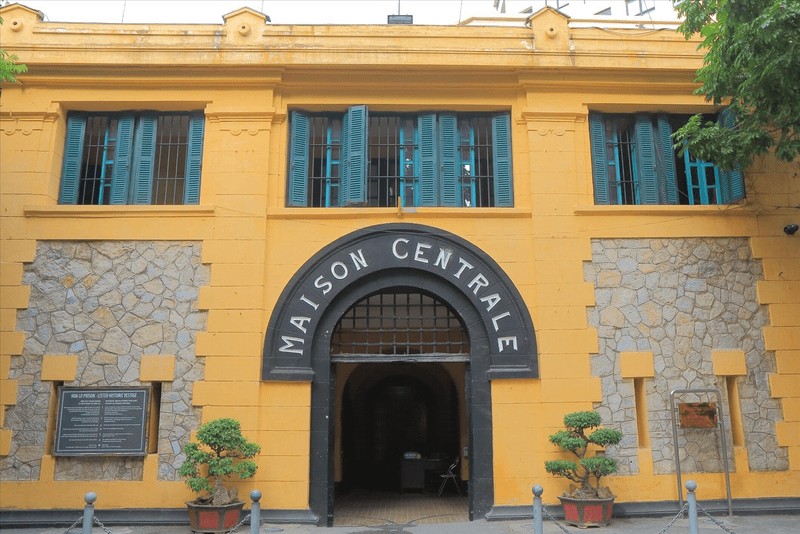 Tourist Attractions Near Quan Su Pagoda
Tourist Attractions Near Quan Su Pagoda
9.5. Temple of Literature
Vietnam’s first university, the Temple of Literature, is a testament to the country’s commitment to education. Explore the serene courtyards and learn about Vietnam’s rich literary history.
10. Why Choose SIXT.VN for Your Hanoi Travel Needs?
Planning a trip to Hanoi and exploring cultural gems like Quan Su Pagoda can be an enriching experience. However, navigating a new city can also be challenging. That’s where SIXT.VN comes in.
10.1. Seamless Travel Solutions
SIXT.VN offers a comprehensive range of travel services to make your Hanoi experience seamless and enjoyable. We provide:
- Airport Transfers: Start your trip stress-free with our reliable airport transfer services.
- Hotel Booking: Choose from a wide selection of hotels to suit your budget and preferences.
- Tour Packages: Explore Hanoi’s cultural attractions with our curated tour packages.
- Car Rental: Enjoy the freedom to explore at your own pace with our car rental services.
10.2. Convenience and Reliability
With SIXT.VN, you can book all your travel needs in one place, saving you time and effort. Our reliable services and dedicated customer support ensure a hassle-free experience.
10.3. Expert Guidance
Our team of travel experts can provide personalized itineraries and expert guidance to help you make the most of your Hanoi trip. We can assist you with everything from choosing the right accommodations to planning your sightseeing itinerary.
10.4. Call to Action
Ready to embark on a cultural adventure in Hanoi? Let SIXT.VN be your trusted travel partner. Visit our website or contact us today to start planning your trip.
Address: 260 Cau Giay, Hanoi, Vietnam
Hotline/Whatsapp: +84 986 244 358
Website: SIXT.VN
FAQ: Exploring Quan Su Pagoda and its Significance
Here are some frequently asked questions about Quan Su Pagoda:
-
What is the best time to visit Quan Su Pagoda?
The best time to visit Quan Su Pagoda is during the cooler months (October to April) when the weather is pleasant. Visiting on weekdays or during off-peak hours can help avoid crowds.
-
Is there an entrance fee to Quan Su Pagoda?
No, there is no entrance fee to Quan Su Pagoda. However, donations are welcome.
-
Can I take photos inside Quan Su Pagoda?
Yes, photography is generally allowed, but avoid using flash and be respectful of other visitors.
-
What should I wear when visiting Quan Su Pagoda?
Dress modestly and respectfully, covering your shoulders and knees.
-
Are there any guided tours available at Quan Su Pagoda?
While there are no official guided tours, you can hire a local guide or join a group tour to learn more about the pagoda’s history and significance. SIXT.VN offers curated tour packages that include visits to Quan Su Pagoda and other cultural attractions in Hanoi.
-
Is Quan Su Pagoda accessible to people with disabilities?
Accessibility may be limited due to the historical nature of the site. It’s best to inquire in advance about specific accessibility concerns.
-
What are the major festivals celebrated at Quan Su Pagoda?
Quan Su Pagoda celebrates major Buddhist festivals such as Vesak (Buddha’s Birthday), Vu Lan (Ghost Festival), and Tet (Lunar New Year).
-
Can I participate in religious activities at Quan Su Pagoda?
Yes, visitors are welcome to participate in religious activities, such as prayer and meditation, but be mindful of the customs and traditions of the pagoda.
-
Are there any restaurants or cafes near Quan Su Pagoda?
Yes, there are numerous restaurants and cafes near Quan Su Pagoda offering a variety of Vietnamese and international cuisine.
-
How can SIXT.VN help me plan my trip to Quan Su Pagoda?
SIXT.VN offers a range of travel services, including airport transfers, hotel booking, and curated tour packages, to make your trip to Quan Su Pagoda seamless and enjoyable. Our travel experts can provide personalized itineraries and expert guidance to help you make the most of your Hanoi trip.
Quan Su Pagoda stands as a testament to Vietnam’s rich Buddhist heritage and its enduring spiritual significance. A visit to this serene sanctuary offers a glimpse into the heart of Vietnamese culture and a chance to experience the tranquility of Buddhist practice. Let SIXT.VN guide you on your journey of discovery, providing seamless travel solutions and expert guidance to ensure an unforgettable experience.



